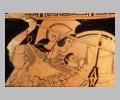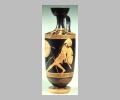
Scene at left: Athena, upper half

Shoulder decoration: satyrs and maenads

Overview: scene from right

Scene at right: Enkelados, upper half

Overview: scene from left

Scene at right: Enkelados, midsection
| Collection: | Cleveland Museum of Art |
| Summary: | Main panel: Athena killing the giant Enkelados. Shoulder: satyrs and maenads. |
| Ware: | Attic Red Figure |
| Painter: | Attributed to Douris |
| Date: | 480 BC |
| Dimensions: | h. 38.0 cm; d. of top (as restored) 8.7 cm; d. of base 9.5 cm; max. d. 14.1 cm. |
| Primary Citation: | |
| Shape: | Lekythos |
| Beazley Number: | 5168 |
| Period: | Late Archaic/Early Classical |
Condition:
Glaze streakily applied in the field of the shoulder scene, between the giant's legs and elsewhere. Glaze fired red-green on the back of the vase, on the handle, top of foot and, slightly, beneath picture zone; minor glaze loss, confined largely to palmettes.
Decoration Description:
Athena and giant Enkelados. Added red: rivulets of blood on giant's body. Everywhere, heavy preliminary outline, relief contour and relief lines everywhere, except on gorgoneion, details of interior of Athena's shield, giant's hair, and dots in the band of the crests of Athena and giant's helmet which are in dilute glaze. The relief is especially high, applied in dots, on Athena's hair. Shoulder: satyrs with a maenad on either side. Interior markings for folds in garments are in yellowish dilute glaze. Above the main scene, frieze of pairs of opposed meanders with dotted-chequer between and below, opposed meanders with saltire-square with dots on arms inbetween.
On the most recently acquired vase in Cleveland, Douris once again employs the strong curve of the lekythos shape to heighten the impact of the scene. Here Douris portrays the death of the giant Enkelados at the hands of Athena in the legendary war between the gods and the giants. The artist has given us the most dramatic, most evanescent moment of this episode, and on this vase has rendered it timeless. Athena, intent on her prey, strides purposefully forward ready to give the coup de grace with her spear. This final blow is not necessary and this the goddess knows, for victory gleams in her eye. An earlier stage of the battle with the giant may be represented on the shoulder of the Priam Painter's hydria in Madison (see
The shoulder is decorated with three figures — a satyr flanked by two maenads. Palmettes and tendrils fill the rest of the shoulder to the handle. The base of the neck is bordered with a tongue-pattern.
The main scene covers less than two-thirds the circumference of the vase. The action unfolds from left to right with Athena in one quadrant striding toward her victory with the giant's broken spear forming a compositional element which ties the goddess spatially to her quarry. The angle of the spear is echoed in the giant's body by the strong diagonals of his left leg and his right arm and short sword. As one turns the vase the giant's already contorted body seems to twist all the more since its axis is curved around the body of the vase.
Athena's profile, the form of her hair, and the drawing of her ear are close to that of Eos on the famed Louvre Eos and Memnon cup (
Douris' composition may have been influenced by the central pediment group from the Old Hekatompedon now in the Acropolis Museum, Athens. There, Athena inflicts the coup de grace on Enkelados who lies defenseless on the ground. While the sculptural group does not lack power, the curve of the red-figure lekythos gives Douris' drawing an impact inconceivable in any other medium.
Although the subject of the War of the Gods and Giants was an old favorite in its own right, it is entirely possible that during the last years of the sixth century B.C. and the beginning of the fifth, this subject matter took on a specific political nature for Athens. With the Athenians on the side of the gods and the Persians cast as giants, the iconography immediately becomes a political manifesto either anticipating or illustrating Athens's victory over the Persian army at Marathon in 490 B.C.
Athens's victory over the giant does not necessarily support a date immediately after 490 B.C. It could be argued, if the political connection is accepted at all, that such a scene was pictured in the hope of victory. Stylistic evidence does, however, support a post-490 date. While the care taken with the textile patterns is reminiscent of the Atalanta vase of 500-490 B.C., I have shown earlier the similarity between the drawing of Athena's face and that of Eos on the later Louvre cup. The palmette decorations on the shoulder approach the style of the later cups such as the Cleveland Douris kylix dated to 480 or after. Thus, a date just after the battle at Marathon and therefore celebrating that victory would be realistic for the lekythos.
Graffiti:
The ghosts of two inscriptions remain:
Essay:
Collection History:
J.H. Wade Fund Purchase (78.59).
Sources Used: